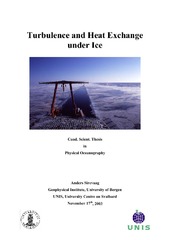| dc.description.abstract | Turbulent fluxes of heat and salt were measured under sea ice at four different locations around Spitsbergen. In Kongsfjorden on West Spitsbergen additional measurements of heat fluxes in the ice and in the atmosphere were done and compared in an air/sea/ice heat budget. Ocean heat flux in Kongsfjorden is about 13 W/m2 and comparison with the other heat fluxes at the ice/ocean interface shows a good agreement. From the heat budget at the ice/ocean interface, the ice growth during three subsequent days in March is calculated to be 4.4 cm. During the same three days the ice growth was measured to be 3.5 cm. The conductive heat flux in the ice is determined by the temperature gradient and the thermal conductivity of sea ice and the ice temperature is calculated from the measured convergence/divergence of conductive heat and absorption of short wave radiation. When the calculated ice temperature in Kongsfjorden is compared with the measured temperature, it shows that the best agreement occurs with a slight reduction of the thermal conductivity of sea ice (~10 – 15%). Turbulent fluxes of heat are also measured in Van Mijenfjorden and in outer parts of Storfjorden. At both locations there are only small amounts of heat in the water column and measured heat fluxes are of order 1 W/m2. Correspondingly, the turbulent fluxes of salt are small and of order -10-6 m/s psu , indicating small ice growth rates. In the so called Whaler’s Bay area north of Spitsbergen, the influence of the West Spitsbergen Current (WSC) is large. The WSC brings relatively warm water along the continental slope of Spitsbergen, resulting in large amounts of heat in the water column. In this area, heat fluxes of order 210 W/m2 were measured 1 m below the ice. Comparison with the conductive heat flux in the ice indicates melting rates of order 5 cm/day. Also the measured turbulent salinity flux in this area shows large rates of melting, about 3.5 cm/day. For all locations, a turbulent exchange coefficient for heat, the turbulent Stanton number, is calculated and the resulting Stanton numbers are in the range 0.006 – 0.007 for the locations Kongsfjorden, Van Mijenfjorden and Whaler’s Bay. | en_US |
